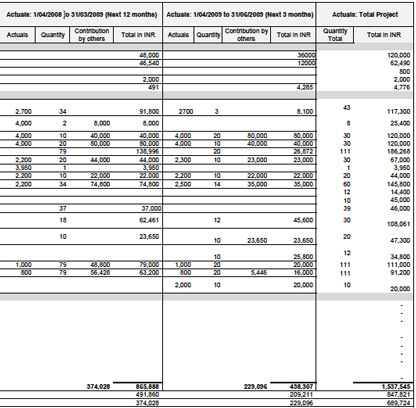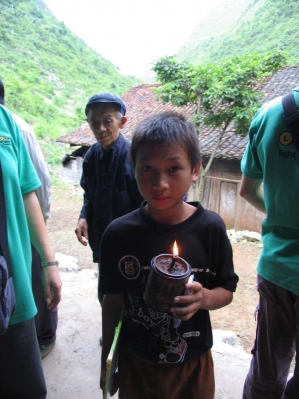Some of our economic impact instruments will focus on measuring the need for essential commodities in pilot communities, including the need for currency. The participants will be surveyed to determine their reasons for working as pedalers and/or purchasing our products. We will follow-up with additional surveys to determine use and usefulness of our products and local currency, and to help identify and monetize specific non-monetary benefits such as reading light. Our survey instruments will be the main tools for our impact studies, which will focus on comparing outcomes between pilot and control communties. In addition to establishing the cost effectiveness of our programs, these results combined with calculating the amortized cost to each pedal-power station for an hour of LED light in each specific community will help each future PPS to determine the best prices and wages to provide the greatest benefit to each business and its community.
The costs of surveys to establish a baseline and to measure outcomes will be mitigated in pilot communities because workers and customers will appear at our stores where they can be verbally questioned by our managers as they work or shop. However, the costs of preliminary studies and impact assessment is expected to take as much as 40% of the initial budjet. In addition, the monetary costs for a typical station will include basic start-up and operating costs, such as management, licensing, property purchase or rental, equipment, product, taxes, labor, and other miscellaneous expenses.

The cost of creating the local currency per se will be largely recouped through seigniorage [15]. Some costs might be offset or reduced initially through private or government aid, such as the provision of facilities that we anticipate from Vigyan Ashram. And some of the general expenses, such as PPS management and labor costs, will be at least partially recouped through sales. The Swavalamban study sited above details a variety of the costs and possible mitigation, but we anticipate our pilot costs will greatly exceed those of Swavalamban because of these additional employee expenses, as well as due to the prelimary and follow-up research, and the broader scope of our program.
As an illustration of cost-effectiveness, our pedal-powered generator might produce about 100 watts of direct current electricity when pedaled at a comfortable, sustainable rate, or about 100 watt-hours of electricity per hour (depending on the stamina of the pedaler). The minimum wage in India is currently about 33¢/hr [16]. However, the price to consumers of electricity from the grid in India is typically about 30¢ per 1000 watt-hours of alternating current. Thus, we pay our workers about ten times as much for electricity produced from pedaling than the cost of that same energy purchased on the national grid. Consequently, our system is not designed to replace the grid but to compete with more-expensive off-grid systems, especially kerosene lanterns that are currently the common means of lighting off-grid. About 100 million families live off-grid in 80,000 villages in India - 400 million people of the 1.5 billion globally without access to electricity - and most of these people depend on light from kerosene [17a].
The 2003 Mills study, conducted at Lawrence Berkely National Laboratories, determined that the simplest and most common wick-based kerosene lamps burn approximately one liter of kerosene in 25 hours [17b], which cost India about 32¢ per liter in 2011 (retail plus subsidy) [17c] (and with each lamp producing around 250 Kg of carbon dioxide per year [17b]).
In India [during 2011], about 400 million persons struggle to survive with 22 rupees a day or less. That's about 50¢, which has a purchasing power in India of $1.25 in the USA. That amount will buy around 2000 calories of food, which is the minimum for a sustaining diet, and this is the basis for the World Bank setting $1.25 in purchasing power per day as the poverty line [3].
A pedaler producing 100 watt-hours of electricity (pedaling for about an hour) consumes about 344 calories [17d].
Putting the numbers together, if we pay the minimum wage for an hour of about 33¢, then that person earns enough to purchase about 1320 calories of food - a nearly 4-to-1 return, and so that hour of pedaling nets the laborer a gain of about half their daily calorie requirement, which is a healthy and healthful profit.
One hour of pedaling provides about 50 hours of light from the Chakra family-sized LED lamp, delivering a 2:1 cost advantage over kerosene. However Mills looked at the amortized cost over three years of useful illumination (lumens) from a 1-watt LED lamp powered by rechargeable NiMH batteries, and he compared that to the light from simple kerosene lamps, calculating a 75:1 cost advantage. This lighting and cost advantage permits multiple low-wattage LED lamps to replace a single kerosene lamp, providing consumers with a commensurate improvement while still achieving dramatic savings. Battery performance has also improved continually since the 2003 study, while the cost of LED lamps has dropped. These trends are universally expected to continue, while the cost of kerosene is anticipated to rise at an accelerating pace.

PPS pedal-powered LED lamps have a great cost advantage over simple kerosene lamps (Photo courtesy Light Up The World [18])
The 50 hours of light from an hour of pedaling can supply the typical needs of ten families per day for one room-sized light each (or several small task lights), signifying a minimum requirement of one of our pedal-powered generators producing for ten hours each day to meet the needs of 100 households. Thus, if each family uses only one of our lamps, this system can employ up to ten million people pedaling one hour each per day, or provide full-time employment for up to one million entrepreneurs operating their independent People Power Stations, and additionally employ many more supplying these businesses with equipment and services.
This pedal-power solution has zero carbon emissions from energy production, and substantially reduces indoor smoke that causes pulmonary disease, as well as elimimates a common source of house fires and burns. Additionally, pedal-power is weather-immune, unlike solar lighting solutions. Most importantly, it provides work to include the poorest in the creation and benefits of a community marketplace. With the proof of concept achieved through the Swavalamban study, the health and ecological advantages, BoPEEI's quality products, and our network of support from Vigyan Ashram, NIPune, and WBR, the potential for the Reconomy strategy to achieve positive community impact on a broad scale is clear.
The Reconomy strategy can build 80,000 community marketplaces in rural India, and half a million more in rural and urban areas around the world, beginning with pedal-power and inclduing every community-sized renewable energy technology. This approach impels sustainable, local development and control of resources, and delivers money and essential commodities to those whom need them most. Reconomy not only raises people out of the bottom of the economic pyramid, it raises the bottom of the pyramid itself, community-by community.
Reconomy Index
l
About
l
Strategy
SunMoney
l
People Power Stations
Summary
l
References
l
Resources